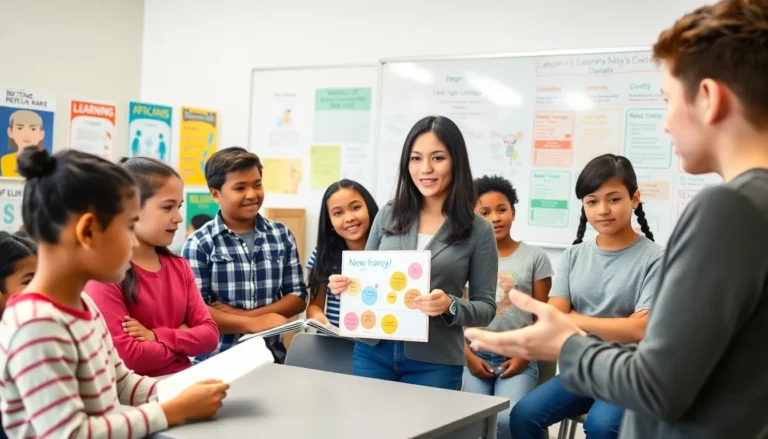Table of Contents
ToggleAs student loan debt continues to soar, many individuals find themselves grappling with the financial burden that follows their education. With millions of borrowers struggling to make ends meet, the conversation around student loan reduction has never been more crucial. Understanding the various strategies and options available can empower borrowers to take control of their financial futures.
From income-driven repayment plans to loan forgiveness programs, there are pathways that can significantly ease the strain of student debt. By exploring these options, borrowers can uncover effective solutions tailored to their unique circumstances. Navigating the complexities of student loan reduction may seem daunting, but with the right information, it’s possible to pave the way toward financial freedom.
Overview of Student Loan Reduction
Student loan reduction encompasses various strategies designed to lessen the financial burden of student debt on borrowers. Borrowers often face overwhelming debt, making it essential to explore effective methods for repayment.
Income-Driven Repayment Plans
Income-driven repayment plans adjust monthly payments based on the borrower’s income and family size. Key options include:
- Revised Pay As You Earn (REPAYE): Caps payments at 10% of discretionary income, with forgiveness after 20 or 25 years of qualifying payments.
- Pay As You Earn (PAYE): Similar to REPAYE, it requires 10% of discretionary income, with forgiveness after 20 years.
- Income-Based Repayment (IBR): Sets payments at 10% or 15% of discretionary income, depending on loan origination date, with forgiveness after 20 or 25 years.
These plans provide manageable payment options for borrowers experiencing financial difficulty.
Loan Forgiveness Programs
Multiple loan forgiveness programs exist for eligible borrowers, primarily for those in public service or specific fields. Notable programs include:
- Public Service Loan Forgiveness (PSLF): Offers total forgiveness after 120 qualifying payments for borrowers working in government or non-profit sectors.
- Teacher Loan Forgiveness: Provides up to $17,500 in forgiveness for teachers in low-income schools after five years of service.
- Nurse Corps Loan Repayment Program: Offers repayment assistance for nurses providing care in high-need areas.
Participation in these programs can lead to significant debt alleviation for qualifying borrowers.
Refinancing Options
Refinancing student loans may provide opportunities for lower interest rates. Key benefits include:
- Potential for Lower Rates: Borrowers with good credit may secure lower interest rates, reducing overall repayment costs.
- Consolidation of Multiple Loans: Streamlining payments into one loan simplifies the repayment process.
Refinancing is recommended for borrowers with stable income and good credit histories, enabling them to ease their financial obligations.
Additional Strategies
Borrowers can also explore various strategies to reduce their student loan debt. Effective strategies include:
- Extra Payments: Additional payments towards principal reduce overall interest and repayment time.
- Employer Repayment Assistance: Some employers offer student loan repayment assistance as part of benefits packages.
- Scholarships for Further Education: Pursuing scholarships for advanced degrees can prevent additional debt accumulation.
Utilizing a combination of these strategies helps borrowers effectively manage and reduce their student loan balances.
Benefits of Student Loan Reduction

Student loan reduction leads to numerous advantages, significantly impacting borrowers’ financial stability and well-being. Understanding these benefits can motivate borrowers to pursue effective strategies for alleviating their debt.
Financial Freedom
Financial freedom emerges as a primary benefit of reducing student loan debt. Borrowers with lower monthly payments gain more disposable income for essential expenses like housing, healthcare, and savings. For example, reducing monthly payments from $500 to $300 allows borrowers to allocate an additional $200 toward investments or savings. Additionally, decreased debt levels can provide greater opportunities for career growth, such as pursuing lower-paying jobs that offer fulfillment and personal growth without the constant pressure of high student debt.
Improved Credit Score
Improved credit scores result from effective student loan reduction efforts. Timely payments on reduced loan balances enhance credit history and demonstrate financial responsibility. For instance, borrowers who lower their debt-to-income ratios often see positive changes in their credit scores. A higher credit score can lead to better interest rates on future loans, increased chances of credit card approvals, and reduced insurance premiums. Importantly, a strong credit profile supports overall financial health, opening doors to homeownership and other significant investments.
Current Legislation on Student Loan Reduction
Current legislation surrounding student loan reduction reflects ongoing efforts to alleviate the financial burden on borrowers.
Recent Policy Changes
Recent federal initiatives include adjustments to existing forgiveness programs and the enhancement of income-driven repayment options. The Biden administration announced a pause on student loan repayments in response to the COVID-19 pandemic, providing temporary relief for borrowers. Additionally, the Department of Education streamlined the Public Service Loan Forgiveness application process, resulting in significant approvals for eligible borrowers. This aligns with efforts to eliminate the backlog of applications and improve access to relief.
Proposed Reforms
Proposed reforms aim to further simplify loan repayment and expand eligibility for forgiveness. One proposal includes automatic enrollment in income-driven repayment plans for new borrowers, ensuring manageable payments that adjust according to income. Another reform proposes the cancellation of a portion of federal student loan debt, targeting low- and middle-income borrowers most affected by the student debt crisis. These reforms seek to create a more equitable system, ensuring that borrowers can achieve financial stability and reduce their debt burdens effectively.
Strategies for Achieving Student Loan Reduction
Numerous strategies exist to reduce student loan debt effectively. Borrowers can leverage different repayment options and forgiveness programs tailored to their financial situations.
Income-Driven Repayment Plans
Income-driven repayment (IDR) plans adjust monthly payments based on a borrower’s income and family size. Key plans include:
- REPAYE (Revised Pay As You Earn): Caps payments at 10% of discretionary income, providing forgiveness after 20 or 25 years, depending on whether loans were for undergraduate or graduate studies.
- PAYE (Pay As You Earn): Similar to REPAYE, this plan requires borrowers to demonstrate financial hardship; payments are also capped at 10% of discretionary income with forgiveness after 20 years.
- IBR (Income-Based Repayment): Distinguishes between new and old borrowers, with payments set at 10% or 15% of discretionary income, offering forgiveness after 20 or 25 years.
Borrowers benefit from lower monthly payments through these plans while working toward eventual loan forgiveness, thus allowing for more effective budget management.
Forgiveness Programs
Forgiveness programs provide borrowers with opportunities to discharge their loans under specific conditions. Notable programs include:
- Public Service Loan Forgiveness (PSLF): This program forgives the remaining balance on Direct Loans after 120 qualifying payments while working full-time for a qualifying employer in public service or eligible non-profit organizations.
- Teacher Loan Forgiveness: Educators who teach in low-income schools or educational service agencies can receive up to $17,500 in loan forgiveness after five consecutive years of service.
These programs alleviate debt for those committed to public service or teaching, facilitating long-term career satisfaction and impact in their communities.






